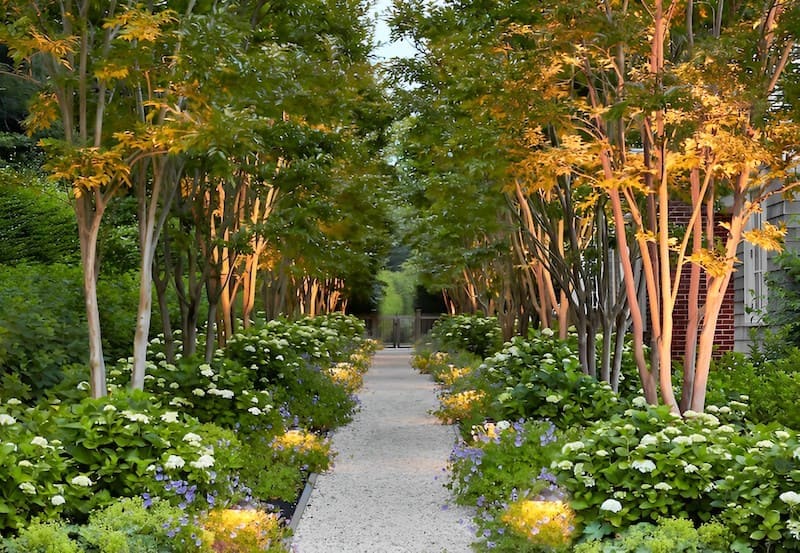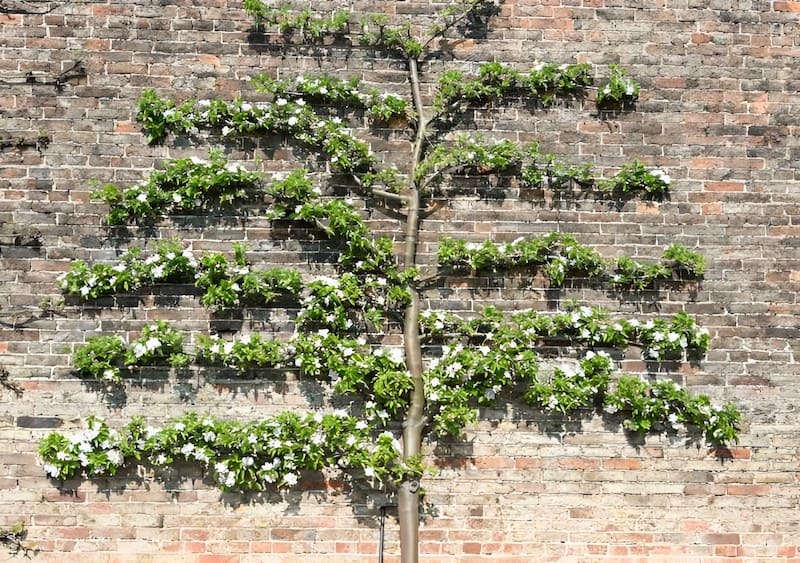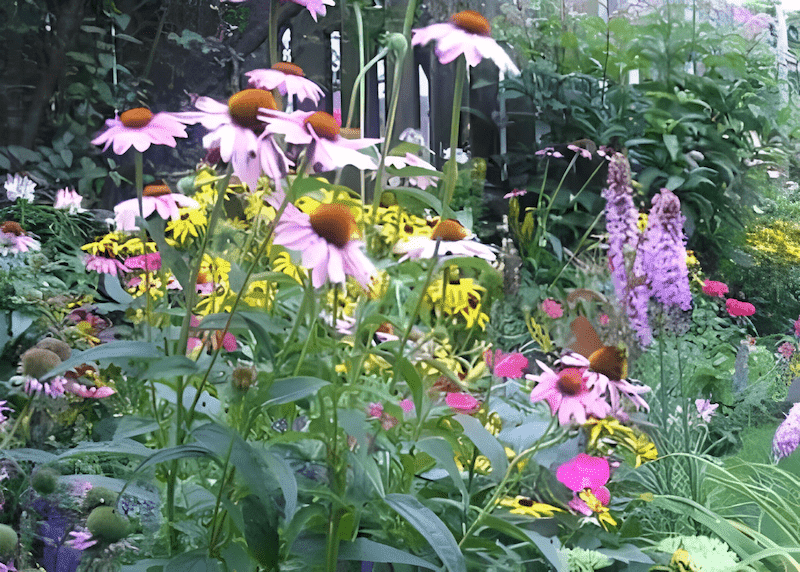
You may be familiar with traditional landscaping—designing your outdoor space with the goal of creating a visually appealing living plant environment. But have you heard of edible landscaping? This innovative trend in home horticulture merges aesthetics with utility, helping you create a beautiful garden that also grows food. Edible landscaping incorporating the growing of fruits, vegetables, herbs, and flowers into your garden design to create a space that is not only aesthetically pleasing but one that can feed your family as well.
Food inflation has prompted renewed interest in urban agriculture, particularly in towns and cities where the price of trucked in produce has increased exponentially due to an increase in the cost of fertilizer and fuel. Space suitable for growing crops can be both expensive and rare despite the interest and need for people to grow food right where they live, however many municipalities are opening more land spaces for urban agriculture.
Community gardens are expanding rapidly in towns and cities across America, particularly in neighborhoods with limited access to fresh produce. Some of these neighborhoods are known as “food deserts”, areas that do not have a supermarket within a reasonable driving distance.
The irregular land shapes of many community growing spaces are not suitable for a conventional rowed garden, which is forcing people to adopt less common horticultural techniques to grow food. One of the most popular is edible landscaping.

Ornamental edibles are plants with a dual purpose, grown for their beauty and ability to produce food in small spaces. These plants should be considered for any edible landscaping project for their additional use as pollinators for the other more common vegetables, herbs and flowers that grow in the garden.
Edible ornamental plants provide an opportunity for you to get creative around the garden, strategically placing specific plants next to others as companion plants to aid growth and ward off pests.
They also create a canvas for living plants of color that have the potential to beautify any urban land space.
A few ornamental plants include Nasturtiums, bright light rainbow chard, purple leaf white flowering basil, daylilies, pineapple guava, runner beans and Russian scarlet kale.
Permaculture is a set of design principles centered around simulating or directly utilizing patterns and features observed in a natural ecosystem. The goal of permaculture in edible landscaping is to create sustainable and self-sufficient agricultural systems that are in harmony with nature.
Principles of permaculture include diversity, stability, resilience, the observation of natural systems, and the mimicking of these systems in a man-made design. For example, plant guilds (combinations of plants that work well together) and food forests (the layering of plants, ground cover, shrubs, and trees) are key strategies in permaculture used to make the most efficient use of space and resources.
Permaculture encourages the use of perennial plants which live for more than two years, reducing the need for constant replanting. Examples of perennials include fruit trees, berry shrubs, and herbs like rosemary and thyme. The use of perennial plants helps increase soil stability, improve soil quality, and enhance biodiversity.
It is also common to use native plants, as these are well adapted to local conditions and generally require less maintenance.
Other types of plants used in permaculture are nitrogen-fixing plants, like legumes, which improve soil fertility.
Companion plants are also a core component of permaculture design. Planting marigolds alongside tomato plants can help to deter pests, reducing the need for chemical intervention, for example.
As a general rule, the plant types you choose should align with the overall goal of creating a balanced, sustainable ecosystem that is beautiful and food productive.
A food forest, a form of agroforestry, is a highly productive and innovative concept grounded in permaculture principles. Designed to mirror the dynamics of a natural forest, it grows plants beneficial to humans.
The objective is to co-grow trees and vegetables in an eco-friendly, sustainable, self-maintaining system with relatively minimal upkeep.
Food forests provide a nurturing habitat for an array of wildlife, including insects and birds which play a vital role in natural pest control and pollination.
By integrating a food forest into your edible landscape, you are creating a bio-diverse ecosystem in an urban landscape that not only secures a source of healthy, fresh food for the community but also supports a wide variety of wildlife.
Guild planting and the planting of companion plants are two strategies that can enhance the productivity and health of your edible landscape. A guild is a group of plants that support each other's growth and productivity. When you plant a guild, you're creating a miniature-ecosystem where each plant contributes something beneficial to the group.

Companion planting, on the other hand, is the practice of planting different plants close to one another for pest control. The planting of companion plants also provide pollination, habitat for beneficial insects, maximize use of space, and increase plant productivity.
Espalier is a horticultural technique that involves training trees, shrubs, and other plants to grow flat against a wall, fence, or trellis. This technique not only creates a stunning visual effect but also allows you to grow fruit trees in small spaces - an ideal solution for urban agriculture and community gardens.
Espalier techniques can be a game changer for edible landscaping in an urban center because it can be used to grow woody fruit bearing plants like apples along a west facing, sun-drenched wall of a building using just 2 or 3 feet of space.

Integrating raised beds into your edible landscape design is a fantastic and functional strategy that adds a whole new dimension to your gardening space. Raised beds can give you a higher level of control over the soil quality, enabling you to customize the soil mix to meet the specific needs of specific plants. By enriching your raised beds with the appropriate soil, compost, and fertilizers, you can create a fertile environment where your plants will grow best.
Raised beds also improve the drainage system, an essential element for many plant types like peppers and tomatoes. They help prevent root rot and many common waterborne afflictions associated with plants that are overwatered.
Gardening in raised beds provides easy access for gardeners. They can be built to a height that eliminates the need to bend or kneel, which will be much easier on the back and they are often wheelchair accessible.
Organic gardening is about more than just avoiding synthetic pesticides and fertilizers. It's about nurturing the soil, promoting biodiversity, and creating a healthy ecosystem in your garden. By following the principles of organic gardening, you can ensure that your edible landscape is not only productive but also sustainable and environmentally friendly.
Organic gardening transcends the mere absence of synthetic pesticides and fertilizers; it’s about nurturing the soil, biodiversity, and the establishment of a thriving ecosystem within your garden.
Organic gardening works with nature, rather than against it, to cultivate a lush, eco-friendly environment ensuring that your garden is a source of nourishment for you, and a sanctuary for life above and below the soil.
Composting turns organic material like leaves, grass clippings, and kitchen scraps into a nutrient-rich soil conditioner that is an essential component of creating an edible landscape. It helps you recycle garden and kitchen waste, reduces the need for artificial fertilizers, improves soil fertility, and promotes healthy, productive plant growth.
Not only beneficial to plants, composting also helps the environment by reducing the amount of waste that goes to the landfill.
This strategy plays an integral role in edible landscaping, providing a sustainable and eco-friendly water source that nurtures your plants. Implementing a rainwater harvesting system in your garden allows you to mitigate your dependence on municipal water supplies and presents an opportunity for significant savings on the cost of water. Beyond the immediate benefits, it also encourages the wise use of water - a valuable and scarce resource in some areas - promoting its conservation and responsible use.
In addition, rainwater possesses natural qualities that are highly beneficial for plants. It is inherently soft, devoid of the chlorine, fluoride, and various other chemicals commonly found in municipal water, thus offering a healthier alternative for watering your garden.
Having a supply of stored rainwater on hand can prove to be a invaluable during drought conditions or periods of imposed water restrictions ensuring your garden remains hydrated and thriving even in times of scarcity.
Choosing drought-tolerant plants for your edible landscape is a smart move, especially if you live in a region with a dry climate or where water use is restricted or scarce. Planting an edible landscape with drought-tolerant plants will save water and require less effort to maintain.
Herbs, like rosemary, thyme, and oregano, are naturally drought-tolerant and some varieties of vegetables, including peppers, tomatoes, and eggplant, can also tolerate dry conditions. And let's not forget about succulents like aloe vera and prickly pear cactus, which not only thrive in dry conditions but also are partially edible.
Vertical gardening is a technique that allows you to grow plants upwards, rather than spreading them out horizontally. This can be a great way to maximize space in a small garden, and it can also add visual interest to your edible landscape.
There are many ways to incorporate vertical gardening into your edible landscape including the use of trellises, towers, walls, and even inverted planters to grow a variety of fruits, vegetables, and herbs. Vertical gardening not only makes efficient use of space, but it can also make your garden more productive when used in tandem with the plant propagation technologies offered by Crop Circle Farms & Gardens.
Pollinators play a crucial role in your garden. These vital creatures, which include bees, butterflies, birds, and even bats, are responsible for plant reproduction through the transfer of pollen from male to female flower parts.
This exchange is what eventually leads to the formation of fruits and seeds, making pollinators vitally important to enhancing the productivity and health of your edible landscape. Without their tireless efforts, many plants would struggle to reproduce, impacting not only the visual appeal of your garden but its yield of fruits and vegetables as well.
Planting a variety of flowering herbs, vegetables, and fruit trees into your edible garden can attract a diverse array of pollinators. For instance, lavender and rosemary are irresistible to bees and butterflies are drawn to plants like dill and parsley.
Fruit trees, especially those with blossoms like apple, cherry, and peach trees, are often buzzing with honeybees and hummingbirds.
Sunflowers, with their large and pollen-rich heads, attract everything from bees to birds to ants.
Native plants such as wildflowers and shrubs are particularly effective because they are well-adapted to the dietary needs of local pollinators. By including a blend of these plants in your garden, you're not only enhancing the aesthetic appeal and productivity of your space, but also save pollinators like the honey bee from extinction.

Edible flowers offer an intriguing dimension to edible landscaping, adding both aesthetic and culinary value to a garden. In an edible landscape, they serve multiple functions: they beautify the garden with their colors and textures, attract beneficial insects, and provide a unique source of flavors for a variety of dishes.
From salads and desserts to teas and garnishes, edible flowers can be utilized to add a dash of color and a hint of unusual taste, transforming ordinary meals into extraordinary culinary experiences that will impress your friends and family.
Some edible flowers are used for their medicinal properties. For instance, calendula flowers are renowned for their anti-inflammatory and wound-healing properties, while chamomile flowers are often used in teas for their calming effect.
Many edible flowers like nasturtiums, marigolds, and sunflowers can lure beneficial insects, contributing to natural pest control and pollination.
Mulching involves spreading a layer of material on the surface of the soil to retain moisture, suppress weeds, regulate soil temperature, and improve soil health. In edible landscaping, mulching with pine straw or crushed bark can also contribute to the overall aesthetic of your garden to the beauty of your garden as well.
Materials like pine straw or crushed bark not only perform the standard functions of mulch but also contribute to the overall aesthetics of your outdoor space. The unique texture and color of pine straw or crushed bark can complement the plants in your garden, providing a natural yet appealing contrast.
Designing your edible landscape calls for a multitude of decisions, one of which is choosing between perennial and annual plants. Perennials are plants that grow for more than two years, re-sprouting and re-growing year after year.
They require less care compared to annual plants so they are an excellent choice for those who prefer low-maintenance gardening. Perennials provide a reliable, consistent structure to your garden due to their longevity, establishing continuity for plant subterranean ecosystems.
In contrast annuals are plants that complete their life cycle within a single year, however this rapid lifecycle requires more maintenance, with the planting of a new plant each year, but this also gives you the opportunity grow an ever-evolving garden.
The changing tapestry of annual plants can inject vibrancy and excitement into your landscape, presenting a continual change of scenery as seasons progress.
Annuals often have the capacity to produce more food per square foot compared to perennials, making them a great choice if you are looking for production from your edible garden.
Local adapted plants, also known as native or indigenous plants, are plants that have evolved to thrive in your local climate and soil conditions. They are naturally resistant to local pests and diseases, require less maintenance, and are more likely to thrive with less watering and fertilizing than non-native plants.
In edible landscaping, choosing local adapted plants can help you create a sustainable and resilient garden. Plus, local plants can help preserve biodiversity and provide habitat for local wildlife.
As we become more aware of the importance of sustainable practices and self-sufficiency, edible landscaping is likely to become even more popular. It offers a solution to many of the challenges we face today, such as food security, environmental degradation, and loss of arable land from urbanization.
Moreover, edible landscaping can play a role in building communities, education, public health and change our relationship with food. The future of edible landscaping is bright, and you can be part of it.
It's a movement that brings together gardeners, foodies, environmentalists, and anyone who values sustainability and self-sufficiency. By adopting the practices and principles of edible landscaping, you can create a garden that is beautiful, productive, and good for the planet. Get started on your edible landscape today—it's a decision you won't regret.
Ready to transform your land into a high-yield, sustainable farm? Let Crop Circle Farms design and build a custom, low-impact, and water-efficient farm tailored to your needs. Double your income and cut your costs in half! Contact Us
Help us expand our mission to revolutionize agriculture globally. We are seeking partners to implement Crop Circle Farms to feed people in need. Together, we can build scalable food production systems that save water, reduce costs, and feed thousands of people. Contact Growing To Give